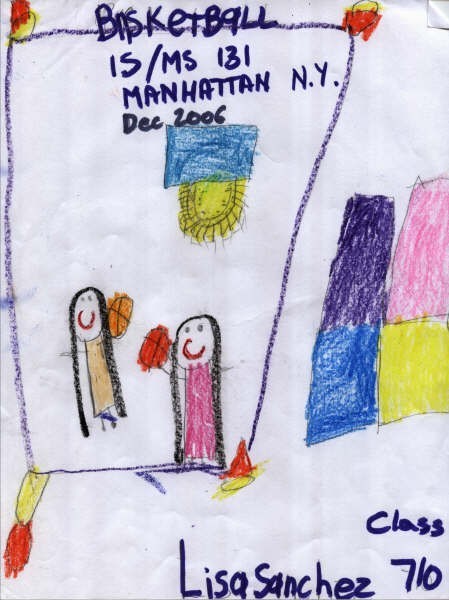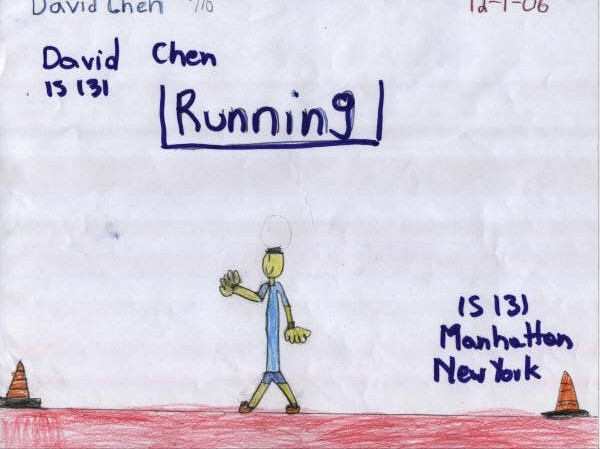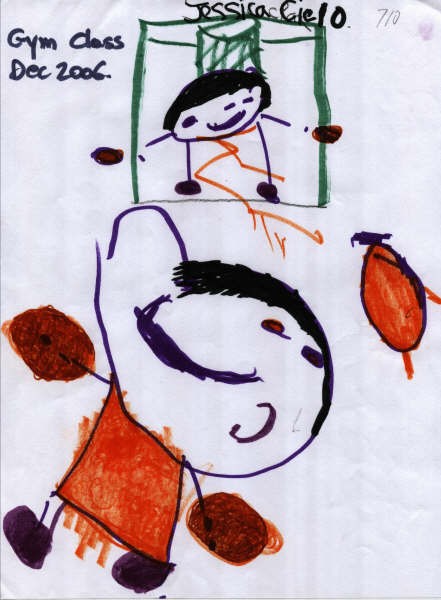Cardio - Vascular Endurance in Physical Education
| Name: |
Ziggy Chodor |
| School: |
PS 124, Manhattan |
| Address: |
40 Division St. |
| City: |
New yYork, NY, 10002 |
| Original Project: |
Cardio - Vascular Endurance in Physical Education |
| Author: |
C. O'Connor |
| URL: |
http://teachnet.ie/coconnor/ |
How did you modify this unit for use in your own classroom?: I chose the fitness project, “Cardio – Vascular Endurance in Physical Education.” Each part of this cardiovascular endurance project has its application in a different portion of my gym class. In this subject we can recognize main components like: muscular endurance, strength, cardio – vascular endurance, flexibility and body composition. In a real life gym scenario, when I do warm-ups with the whole class, I tell them what we doing. I quickly explain the purpose of warm up. In the first part of the warm-up, we are increasing elasticity – flexibility of arms and legs. I instruct my students to repeat out loud terms like “A warm-up is good;” “I like stretching;” “A warm-up is good for me.” The talking part can not be long, only two short sentences. Children get bored very quickly if a teacher is talking too much. During a warm up and also in other parts of the class, I instruct my students to count out loud with me, “One, two, three, four …” This engages students to actively participate in class, and also makes them memorize faster all the components of the appropriate fitness class. After warm ups, we always do jogging. Each student jogs the appropriate amount of seconds for him or her. We analyze the technique of the most advanced students. After running, all the students learn how to count their heart rate /pulse. We try to do this before and after the exercise. This teaches them about the cardiovascular system in the human body. During every class we spend 2-4 minutes discussing the components of all of the fitness related issues. I pick only one component every class. For example, I tell them that we will talk today about muscle endurance vs. muscle strength. I explain this to students in very simple language suited to their academic level. Than I tell them to answer my questions, which reflect how much they remember of the new information. I give them points on the roster for correct answers. During every class we will discuss one of the subjects like muscular endurance, muscular strength, cardiovascular endurance, heart rate, flexibility, body composition, agility, reaction time, power, coordination, balance and speed. I make sure that subjects we discuss on a given day, we also practice. If we discussed balance as an aspect of fitness, we will immediately do some exercises for balance and coordination. I make sure that the students in my special education class see the real application of the theoretical information. I tell them short stories about their favorite heroes mixed with fitness related information from this project.
List your primary instructional objectives for your students.
| |
1. My primary objective is to build heath and fitness related components like: muscle endurance, strength, cardiovascular endurance, flexibility, and proper body composition. In one of the parts, I try to increase cardiovascular endurance in my special education students. I make sure that they do jogging during every class, right after the group warm up. We also use counting of the heart rate/pulse before and after the jog. |
| |
2. My secondary objective is to increase their neuron- muscular coordination, agility, balance, reaction time, power and speed. We would repeat simple coordination techniques from different sport disciplines over and over again until their coordination during a specific sport has improved. It requires a lot of patience to do this with my special education students. Sometimes it can take 4-6 months to teach them how to run properly or how to hold the baseball bat properly. Each month we practice different sport disciplines. For example, September is fitness testing month and general fitness exercise. The test given is the TGMD-2 Fitness Test. It has two parts. One part is the neuron-muscular coordination test. This measures object – control abilities of the student. The other part of the test is measuring gross motor fitness abilities of the student. This is a specific test for special populations. The tests measure students’ cardiovascular level, their strength, and other fitness components. |
| |
3. My third objective is to increase student strength. At the beginning of each class, we always do the same basic strength exercises which are incorporated into the warm up. It takes only 3-4 minutes to finish them. These strength exercises include push-ups, modified sit-ups, and squats. The exercise is part of warm up and is done on regular basis, to create good exercise habits within students’ minds. Also, constant repetition of the same techniques allows students to learn the movement pattern and improve their coordination. We have to remember that special education students require more time to learn basic movements and basic coordination sequences. For regular students it is almost natural to do push ups or running, but for the special education student, it takes sometimes 6 months to be familiar with these types of coordination patterns. |
| |
4. My fourth objective is to increase knowledge about healthy eating habits and also create a homework routine of doing daily exercises. My students have very poor orientation about what healthy eating is. Obesity and overweight students are visible in each school. I have my students repeat a list of healthy foods. They repeat after me, “Vegetables are good for me;” “Fish is good for me;” “Fruits are long life;” “Junk food is bad for my health;” “Soda is bad for my health;” “Cake is bad for my health;” and “Potato chips are bad for my health.” We chant these phrases during every gym class. Also, I make sure to give them homework. Their homework includes 3 very simple exercises like: 10 push ups, 10 modified sit ups, and 10 jumping jacks every day. If students do the homework, they receive extra credit in the roster. I motivate them by giving prizes to the most disciplined students. Students who receive the most of the points get prizes at the end of the semester. (Of course, everybody receive prizes at the end of semester). |
What role did technology play in this curriculum unit?: Technology is a critical part of my teaching unit starting from the simple record player to create rhythm and support for gym warm-up, to relaxation music for the cool down part of the gym class. Also, I use “Fitness Professionals” a professional exercise computer programs with pictures that each student receives, allowing them to exercise at home. The program is used for teaching a variety of fitness classes. “Fitness Professionals” is published by Power System. The exercise pictures I always use illustrate simple, basic exercises like: pushups, sit ups, squats against the wall, and other exercises.
How did you assess and evaluate student performance?: Evaluation: The basic test to evaluate the special education students’ fitness progress is theTGMD-2 Test. This fitness test is designed for special education students with IEP Personal Files in New York City Public Schools. There are two parts in this test. The first part of the test is gross motor development test. This test includes testing ability in run, gallop, hoop, leap, horizontal jump and side slide. The second part includes the object control skills test. This part includes: striking a stationary ball, stationary dribble, catch the ball, kick the ball, overhead throw of a small ball, and on the ground roll of the ball. The second type of evaluation I introduce to my students is giving them points/grades for every gym class’ tasks. This type of monitoring in the roster/student list shows me their progress in strength, speed, flexibility and improvement in the cardiovascular system. I measure their times of running around the gym. Also, I monitor their heart rate. All of these evaluative techniques show us how much progress the students made.
Please tell us briefly about your background & teaching experience: Background : I graduated from Technical High School in the town of Chelm, Poland in 1979. In High School I was an active athlete and participated in sports related clubs including Martial Arts Club - Karate Kyokushinkai, Winter Cross Country Skiing, and Summer Track and Field. College level: I graduated from the University of Physical Education in Warsaw, Poland in 1985. I was involved on competition level with the same sports: Kyokushinkai Karate, track and field, and also in swimming. I received a B.S and M.S in Physical Education. I came to New York in 1989, to compete in the International Martial Arts Competition. I was able to stay with the Karate Club in New York City, and continued to be sponsored by it. I graduated from Brooklyn College with an M.S. in Sport Rehabilitation in 2005. Right now I work full time for the New York City Department of Education. I do fitness rehabilitation with physically and mentally disabled children in 5 different schools in China Town and downtown Manhattan. The DOE department I work under is Adaptive Physical Education. By working with special education students, I realize every day how lucky I am. Every day I an thankful for my body. I’m just happy to be able to walk. I’m happy to have two hands and two legs. You don’t know how lucky you are until you see these disabled children. They make my heart soft.
What are your recommendations for other teachers interested in adapting this unit?: Recommendation: My first recommendation about this cardiovascular program is to translate difficult, professional language used in this unit to the level that children can understand. The second recommendation is to utilize/ transform only small portions of this large program and use it in a real gym scenario, step by step. The third recommendation is to make sure that you give the prizes or scores to the students. This will motivate them to a much greater extent. High level knowledge of the information used in this project is useful only if you are able to present it to the students in simple and motivating way.
Additional pages: Sample of fitness pictures I distribute to the students to be used in conjunction with homework
Samples of Student Projects
| |
Picture: I attached paintings and drawings of my special education students. This beautiful work shows their interest in different forms of fitness. I asked them to draw their favorite fitness activities. Art work makes them more interested in sports and allows them to be more active in class participation. All of the work shows their favorite fitness activities and favorite sport disciplines. The attached picture is the work of special education student, Lisa Sanches, from class 710. She shows her most interesting moments from gym class at IS 131, Manhattan. |
| |
 |
| |
|
| |
Project 2:David Chan likes the part of the gym class when we run. His painting shows him running happily. |
| |
 |
| |
|
| |
This work project is done by Jessica Cielo. She likes basketball drills very much. |
| |
 |
SELECT *
FROM TeachNetAdaptors08
where approved = 'yes'
order by projectname
|